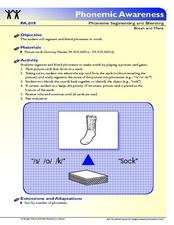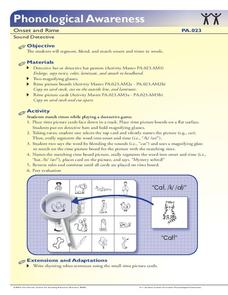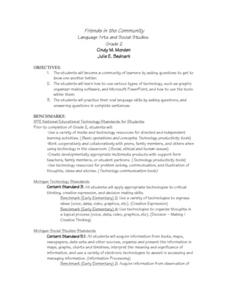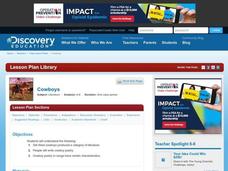Florida Center for Reading Research
Phonemic Awareness: Phoneme Segmenting and Blending, Break and Make
Young learners build phonemic awareness and strong phoneme blending skills. Pairs guess the image on the card based on the word segment sounds given by blending what they hear.
Pyro Innovations
Phonemic Awareness
What was the sound that letter made? The letter S is the phoneme of today's lesson and it is ready to make an appearance. Little ones discuss the sound S makes, then they hold up S cards every time they hear words containing the initial...
Florida Center for Reading Research
Phonics: Varient Correspondances, Silent "e" Changes
Engage early readers in a silent e activity to help them understand the changes the letter can make to a simple word. With the provided cards, learners read and write each word as it appears without the silent e. Then they read and write...
Florida Center for Reading Research
Phonological Awareness: Onset and Rime, Sound Detective
Play letter sound detective with your class, and snoop out sounds, onsets, blends, and rhyme. In pairs, children take turns choosing a card from the pile; as they sound out part of the word, their partner attempts to figure out which...
Florida Center for Reading Research
Word Steps
Blending basic CVC letters to make words is one of the first steps to independent reading. Provided here are several images of stairs and several letters to cut and arrange. The learner rearranges the letters to form CVC patterns, sounds...
Florida Center for Reading Research
Phonics: Onset and Rime, Change-A-Word
Kids use their phonological know-how to identify and segment onset and rime blends. Double rime picture cards (cat and hat) are chosen, then matched to onset cards that make each word, such as the k sound for a cat and the h sound for a...
Florida Center for Reading Research
Phoneme Split and Say
Little ones are provided with all the tools needed to begin segmenting phonemes. There are twenty Elkonin box picture cards, five blank Elkonin box cards, and full instructions on how to help pre-readers practice splitting and saying...
Curated OER
Friends in the Community
Second graders build a classroom community by getting to know each other better. They ask classmates various questions and use graphic organizer software and Microsoft PowerPoint. Students practice their oral language skills while asking...
Florida Center for Reading Research
Phonological Awareness: Phoneme Segmenting, Phoneme Closed Sort
Build phonological awareness with an activity that challenges learners to sort picture cards based on the number of phonemes each has.
Channel Islands Film
A Time Capsule of a Lost Early California Lifestyle
After viewing The Last Roundup, a documentary that examines the transitioning of Santa Rosa from a privately owned island to a National Park, class members adopt the point of view of Tim Vail, a member of the family that once owned the...
Florida Center for Reading Research
Phonics: Encoding and Decoding, Three-In-One
Scholars use the provided pack of alphabet cards to construct basic CVC words, then write down each word they make in one of two columns. Column one is for real words and column two is for nonsense words.
Curated OER
Now You're Speaking My Language; Deciphering the Symbols of Early Civilizations
High schoolers explore early attempts at written language. For this early civilizations lesson, students investigate first attempts at written communication. Among the civilizations covered are Mayan, Greek, and Egyptian.
Pennsylvania Department of Education
Pictures and Print: What's the Difference?
Learners watch a PowerPoint presentation. For this early literacy lesson, students watch a PowerPoint presentation describing print from pictures and the difference between the two.
Curated OER
Cowboys
Students analyze cowboy literature. For this United States history and literacy lesson, students listen to a variety of cowboy songs and poetry, view the video "Rediscovering America: The Real American Cowboy," and view related websites....
Curated OER
Text as Object and Art: Aesthetic Impact on Audience Reception of Books in the Early Renaissance and Today
Tenth graders examine the role that aesthetics play in the publication of books. In groups, they apply the concept of physical affectation on each reader's experience to literature. They also compare and contrast the varied types of...
Curated OER
What's in the Time Capsule? A Technology-Connected Lesson Plan
Twelfth graders use computers and the Internet to research a specified area, word processors to prepare an essay, a digital camera, a video camera gather visuals, and a scanner to add visuals to a PowerPoint presentation as they discover...
Curated OER
Texture Hunts and More: Madonna and Child with Saints
Students investigate different painting techniques by studying classic works of art. In this art history lesson plan, students observe the famous Madonna and Child with Saints painting and describe the texture and images they notice....
Curated OER
The New England Fishing Industry:Sea Changes in a Community
Explore New England's economic and cultural past and possible issues New Englanders will face in the future. Middle and high schoolers research the fishing industry and the need for regulation. They analyze the topography of New England...
Curated OER
Sea Changes: A New England Industry
Students conduct research in order to use primary and secondary sources. They interpret and analyze information from textbooks and nonfiction books for young adults, as well as reference materials, audio and media presentations, oral...
Denver Art Museum
From the Hat’s Point of View
Here is a lesson designed for pre-schoolers and kindergartners that will pique their imaginations. They study images of a very interesting ceremonial hat from China's past called a Summer Official's Hat. These hats were worn by people of...
Curated OER
Finding Meaning in the Badge
Children who are three to five years old study two rank badges from the Qing dynasty to develop an understanding of social rank, language skills, and symbolism. The instructional activity is discussion-based and requires learners to...
Curated OER
Discovering the Journal of Augustus Pelletier
Students explore journals. In this Discovering the Journal of Augustus Pelletier lesson, students read the historical fiction book and conduct research activities to validate events in the plot that reflect the Lewis and Clark...
Curated OER
A Peaceful Place Is Powerful for the Mind
Fourth graders explore, analyze and interpret how schools can become peaceful places to learn and interact with others. They study a wide variety of avenues to achieve this task through classroom, community and career activities...
Curated OER
An Early Canadian Photo Album
Students search the Images Canada database for images depicting life in Canada in the late 19th and early 20th centuries. They analyze photos and share their findings. They use these images to create a photo album.

























